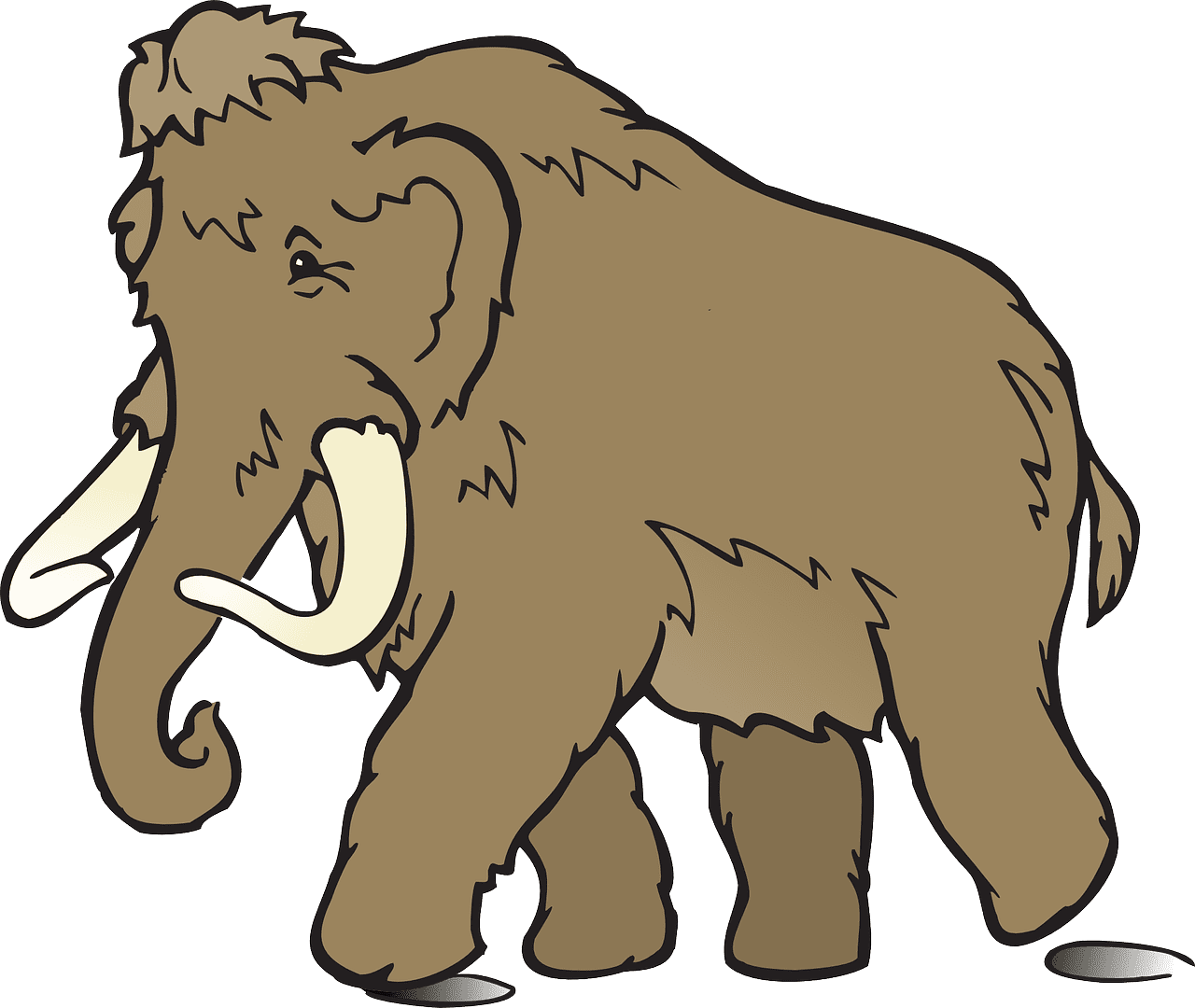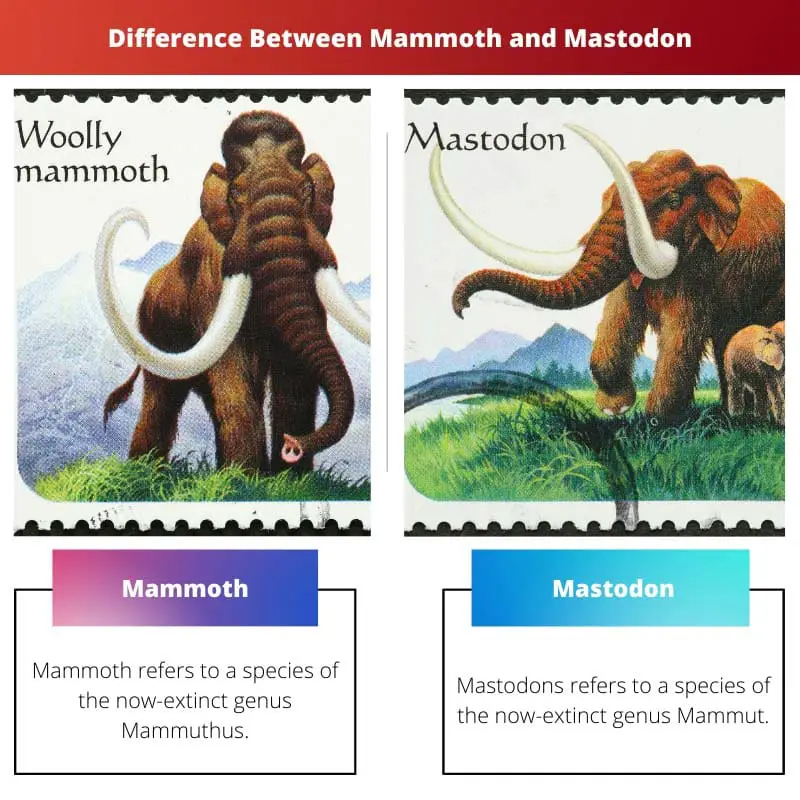Mammoths and Mastodons are two different species that belong to the Proboscidean family.
Although both species lived together in the ice age before the extinction of the mastodons, they have significantly distinct traits, which assure that they are not the same species.
Mammoths and Mastodons are different on several grounds, such as physical characteristics, height, weight, family of origin, habitat and the like.
Key Takeaways
- Mammoths had a more slender build and long, curved tusks, while mastodons had a stockier build and straighter, more robust tusks.
- Mammoths lived in grasslands and tundras, while mastodons inhabited forests and wetlands.
- Mastodons had cone-shaped teeth for crushing vegetation, while mammoths had flat, ridged teeth for grinding grass.
Mammoth vs Mastodon
Mammoths were large, woolly elephants that lived during the Ice Age. Mammoths had long, curved tusks that pointed upward, and their tusks could grow up to 15 feet long in some cases. Mastodons were also large prehistoric elephants but differed from mammoths in several ways. Mastodons had shorter, straighter tusks that pointed downward, and their tusks could grow up to 8 feet long in some cases.

Mammoth refers to a species of the extinct genus Mammuthus. They belong to the family of Elephantidae.
A mammoth has long, curvy tusks, a short tail, large ears, and a high, peaked head;
The weight of a mammoth ranges from 5.4 to 13 tons, with a height of 8 to 12ft. In addition, mammoths were grazers with molars specially adapted for eating grass.
Mastodons refer to a species of the extinct genus Mammut, belonging to the family of Mammutidae. A mastodon has long, curvy tusks, a long, hairy tail, small ears, and a low head.
The weight of a mastodon ranges from 5 to 8 tons, with a height of 7 to 8ft. In addition, mastodons were wood browsers with molars specially adapted for eating woody browse.
Comparison Table
| Parameters of Comparison | Mammoth | Mastodon |
|---|---|---|
| Definition | Mammoth refers to a species of the now-extinct genus Mammuthus. | Mastodons refers to a species of the now-extinct genus Mammut. |
| Lifespan | 60-80 years | 60 years |
| Weight | 5400 to 11790 kg | 4535 to 7260 kg |
| Height | 2.4 to 3.6 metres | 2.1 to 2.4 metres |
| Tail | short | long, hairy |
| Ears | large | small |
| Head | high, peaked | long, low |
| Habitat | The mammoth habitat was the Mammoth steppe, a landscape with rich herb and grass vegetation | The habitat of mastodons was a Forest dwelling, wherein the mastodon fed on sylvan vegetation. |
| Family | Elephantidae | Mammutidae |
What is Mammoth?
Mammoth refers to a species of the extinct genus Mammuthus, first encountered in Africa about 5.1 million years ago. They belong to the family of Elephantidae.
A Mammoth, along with long, curvy tusks, a short tail, large ears, and a high, peaked head, had sparse to woolly fur. The weight of a mammoth range from 5.4 to 13 tons, with a height of 8 to 12ft.
In addition, mammoths were grazers with molars specially adapted for eating grass.
The habitat of a mammoth is the Mammoth steppe, which is a periglacial landscape with grass vegetation and rich herb.
Mammoths, primarily inhabiting the northern, ice-covered regions, possessed fatty humps on their backs that endowed them with essential nutrients to survive in cold conditions.
They lived from the Pliocene epoch to the Holocene period on Earth.
Mammoths had a life of 60-80 years. They first came into being discovered in Africa, Europe, Asia, and North America.
This species of organisms perished about 10,000 years ago. In addition, mammoths stand closer to present-day elephants in their appearance and constitution.

What is Mastodon?
Mastodons refer to a species of the extinct genus Mammut, discovered on the planet about 27 to 30 million years ago.
A mastodon with long, curvy tusks, a long, hairy tail, small ears, and a low, long head belongs to the family of Mammutidae.
The weight of a mastodon ranges from 5 to 8 tons, with a height of 7 to 8ft. In addition, mastodons were wood browsers with molars specially adapted for eating woody browse.
The mastodons were native to North and Central America. The habitat of a mastodon is forest-dwelling, with mastodons feeding on sylvan vegetation.
They lived from the late Miocene to the Pleistocene period on Earth. Mastodons were shorter and stockier than mammoths.
Their name coincided with the shape of their teeth. Mastodon originates from Masto, that is, breast in Greek, and Odon is teeth in Greek.
Mastodons perished about 10,000 years ago. There are several reasons for their extinction.
However, the most significant reason was the mastodon’s inability to cope with the increasing temperatures. Hunting of these animal species was another reason for their extinction.

Main Differences Between Mammoth and Mastodon
- Mammoths refer to a species of the extinct genus Mammuthus. On the other hand, mastodons refer to a species of the extinct genus Mammut.
- Mammoths belong to the family Elephantidae; mastodons belong to the family Mammutidae.
- A mammoth has a short tail, large ears, and a high, peaked head. In contrast, a mastodon has a long hairy tail, small ears, and a low, heightened head.
- The mammoth had a weight of 5.4 to 13 tons and a height of 8 to 12 ft. The mastodon had a weight of 5 to 8 tons and a height of 7 to 8ft.
- Mammoths arose about 5.1 million years ago in Africa. In contrast, mastodons came into existence about 27 to 30 million years ago.
- The mammoth habitat is a Mammoth steppe-periglacial landscape with rich herb and grass vegetation. On the other hand, the habitat of a mastodon is a forest-dwelling, with mastodons feeding on sylvan vegetation.

- https://www.ucpress.edu/book/9780520253193/mammoths
- http://digitallibrary.amnh.org/bitstream/handle/2246/7179/guideleaflet043.pdf?sequence=1

The details about the lifespan and habitats of mammoths and mastodons were enlightening. It’s clear that they were well-suited to thrive in specific ecological niches.
Absolutely, it’s evident that mammoths and mastodons had evolved to fit different habitats, aiding in their survival throughout the ages.
The comprehensive insights into mammoths and mastodons are truly engaging. It’s fascinating to learn about the interplay of ecological factors and their impact on these prehistoric giants.
Absolutely, the discussion of mammoths and mastodons offers a rich understanding of how environmental changes and adaptations influenced the evolutionary trajectory of these species.
The article adeptly explores the ecological dynamics of mammoths and mastodons, showcasing the complex interplay between their biological traits and the habitats they inhabited.
The detailed comparison between mammoths and mastodons provides an insightful understanding of these prehistoric creatures. It’s fascinating to delve into their distinct evolutionary paths and ecological roles.
Indeed, the article admirably captures the unique attributes and evolutionary adaptations of mammoths and mastodons, enriching our knowledge of prehistoric biodiversity.
The historical context and ecological insights into mammoths and mastodons are incredibly valuable. It’s essential to understand the role these prehistoric animals played in their respective ecosystems.
Absolutely, gaining a holistic view of mammoths and mastodons is crucial in understanding their ecological impact and significance in natural history.
The in-depth analysis of mammoths and mastodons offers profound insights into their evolutionary pathways and ecological adaptations.
The scientific details provided are truly enlightening. It’s remarkable to see the intricate adaptations and ecological preferences of mammoths and mastodons.
Indeed, the information presented allows for a deep understanding of the unique features of mammoths and mastodons, contributing greatly to our knowledge of prehistoric biodiversity.
The article provides an exceptional overview of the characteristics and behavior of mammoths and mastodons, offering valuable insights into their prehistoric contexts.
This article does a great job explaining the fundamental differences between mammoths and mastodons. It is interesting to know that they were both large prehistoric elephants that coexisted during the ice age.
Yes, it’s fascinating to learn that mammoths and mastodons had such different physical characteristics and habitats despite being similar species.
The description of mammoths and mastodons, along with their distinguishing features, was highly informative. It’s truly remarkable how these creatures were shaped by their environments.
Absolutely, the adaptations of mammoths and mastodons to their habitats truly make for an intriguing study in ecological diversity and evolution.
The information provided about the physical characteristics and habitat preferences of mammoths and mastodons is invaluable. It truly highlights the diversity of prehistoric proboscideans.
Agreed, the article does an excellent job in detailing the unique attributes of mammoths and mastodons, shedding light on their differing ecological roles.
The insights into the dietary preferences of mammoths and mastodons are fascinating. It’s intriguing to learn about their distinct food sources and the corresponding adaptations.
The comparison table was very helpful in understanding the differences between mammoths and mastodons. It’s interesting to see how their weights and heights varied despite being part of the same proboscidean family.
The information about their lifespans and physical attributes was highly informative. It’s amazing to see how these prehistoric creatures were adapted to different environments.
Absolutely, I appreciate the clarity provided in the comparison table. It really emphasizes the distinct features of mammoths and mastodons.
The level of detail provided about mammoths and mastodons is commendable. It offers a comprehensive understanding of the differences between these magnificent creatures.
Indeed, the article’s thorough analysis of mammoths and mastodons contributes greatly to our appreciation of their unique biological characteristics.